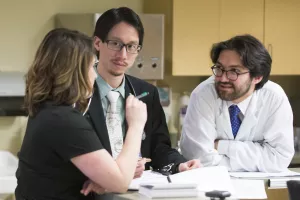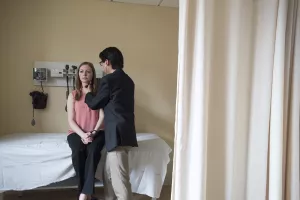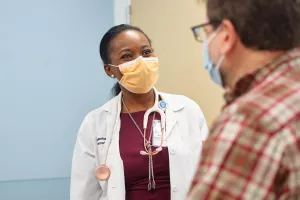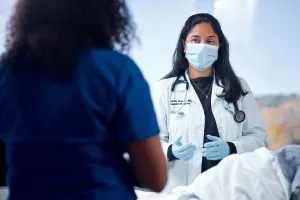Be fast if you think it might be a stroke—call 911 or head to the nearest emergency department. Early treatment can prevent brain damage. Every minute an artery is blocked due to a stroke, 2 million brain cells die. Rapid treatment improves outcomes and saves lives.
Stroke
Every second matters
Did you know that 80 percent of strokes can be prevented, according to the American Heart Association and American Stroke Association? A stroke can be a scary and alarming situation. It happens when a blood vessel in the brain becomes blocked or bursts, causing damage to the brain cells with each passing moment. There is hope after a stroke with monitoring, medications, lifestyle changes and sometimes rehabilitation.
If you suspect that you or a loved one is experiencing a stroke, remember that time is of the essence. Call 911 immediately.

Stroke care near you
The Comprehensive Stroke Center at Tufts Medical Center brings together a multidisciplinary team that provides treatments for various cerebrovascular disorders such as ischemic strokes, transient ischemic attack, intracerebral hemorrhages, subarachnoid hemorrhages, cerebral venous sinus thrombosis, carotid artery stenosis and many more.
Our clinicians work with specialists and therapists to find the best treatment plans for each patient. We are committed to reducing the risk of stroke, treating acute stroke, preventing stroke recurrence, guiding recovery, rehabilitation and adaptation following a stroke.
We also offer services for stroke survivors under the age of 50 by providing longitudinal care and support for young adults.
Lowell General Hospital is a designated Primary Stroke Service (PSS) facility by the Massachusetts Department of Public Health. As part of this designation, the hospital must provide 24/7 emergency diagnostic and therapeutic services to patients with acute stroke symptoms and educate the public about stroke warning signs. This ensures that anyone eligible can receive IV-tPA treatment within hours of their symptoms.
MelroseWakefield Hospital is a designated Primary Stroke Service (PSS) facility by the Massachusetts Department of Public Health. As part of this designation, the hospital must provide 24/7 emergency diagnostic and therapeutic services to patients with acute stroke symptoms and educate the public about stroke warning signs. This ensures that anyone eligible can receive IV-tPA treatment within hours of their symptoms.
Conditions
Strokes, sometimes called "brain attacks," occur when blood vessels supplying the brain, spinal cord or eye are injured. When the cells are damaged, blood flow is interrupted, and your brain can't tell your body to do certain things like move your face or limbs, speak or understand what others are saying. Depending on the type and location of the stroke, these functions may be impaired or lost.
There are two main types of strokes:
- Ischemic stroke: a blockage of a blood vessel supplying a specific portion of the brain, resulting in loss of oxygen and nutrient delivery to that area.
- Intracerebral hemorrhage: a rupture of a blood vessel supplying the brain, resulting in bleeding into the brain tissue.
Stroke symptoms
Symptoms can vary from mild to severe and can be gradual or even come and go. Watch for:
- Difficulty closing your eyes or moving your mouth
- Trouble moving your arm or leg on one-sided
- Loss of sensation, numbness or tingling on one side of the face or body
- Difficulty speaking and understanding others
- Vision impairment in one or both eyes
- Poor arm and leg coordination
- Balance problems or falling
B.E. F.A.S.T. Stroke Awareness
If you or a loved one ever experiences any of these symptoms and you believe you are having a stroke or symptoms that cannot otherwise be explained, call 911 immediately.
Testing
Diagnosing the type of stroke you've had is like detective work. We specialize in reviewing the evidence, ruling out other culprits and zeroing in on the main suspect.
We'll ask about your symptoms, perform physical and neurological exams and monitor your condition. Our physicians, nurses and emergency medicine technicians may ask you the same questions several times to tease out additional details from your memory.
Finally, brain imaging will give us the clearest picture of where the "attack" occurred. Honing in on the cause and location of the stroke provides us the best information to tailor your treatment plan.
Some of the tests we use to look for clues include:
- Blood tests
- Brain and pelvis magnetic resonance imaging (MRI)
- Cardiac telemetry
- Catheter angiogram (a safe, minor test used to take images of arteries in your head and neck)
- Chest X-ray
- Computerized tomography (CT) scan
- Doppler ultrasound of the legs (an ultrasound of leg veins to look for deep vein clots)
- Echocardiogram
- Electrocardiogram (ECG or EKG)
- Head and neck CT angiogram
- Urine tests
Treatments
Strokes can be disabling or life-threatening. Getting emergency medical care as fast as possible gives you the best chance of minimizing long-term effects. During the first 24-48 hours in the hospital, our emergency physicians, nurses and technicians will stabilize you to prevent your stroke from worsening or causing new strokes.
You may be in the hospital for a few days or weeks, depending on the type of stroke you experienced and your complications. Everyone's recovery journey is different. You can count on our team to comfort and guide you.
Your treatment plan may also include:
- Medication like aspirin and Plavix prevent clots from forming and causing more strokes
- Intravenous fluids (IV in the arm) may be given to make it easier for your heart to deliver blood and nutrients to your brain
- Blood pressure monitoring
Ischemic strokes strike when a blood vessel that supplies oxygen and nutrients to the brain is blocked. Immediate treatment for this type of stroke is to open the blockage and restore blood flow to the brain.
Depending on when you arrive at the hospital or when the stroke started, you may receive intravenous medication from your arm (intravenous tissue plasminogen activator or IV tPA) to dissolve clots. This medication is the gold standard of care for ischemic strokes and is proven to reduce long-term disability.
You may require surgery if your stroke causes a major artery to be blocked. We'll make minor cuts and thread a thin, flexible tube called a catheter up to the neck and head arteries to remove the clot. You'll be in the expert care of our experienced neurosurgeons, neurologists and interventional radiologists.
Intracerebral hemorrhage care targets the area of the brain where blood vessels have ruptured. We quickly stop or slow bleeding in the brain, repair damage and prevent complications. Bleeding in the brain can be worsened by uncontrolled high blood pressure, abnormal blood vessels and coagulopathy which is excessive bleeding or clotting. Treatments include:
- Medication to lower blood pressure
- Medications to reverse complications from blood thinning medications or medical conditions like liver disease
- Minor surgery using thin wire catheters to treat abnormal blood vessels
- Extensive bleeding that is life-threatening may require neurosurgeons to remove blood or relieve pressure on the brain
Strokes that happen in people under the age of 50 are becoming more common. Our stroke and young adult program cares for young adults who have had a stroke and is built to help identify causes of the stroke, optimize prevention of future strokes, estimate the risk for recurrent stroke and late complications of stroke, and provide counseling on stroke survivorship.
Rehabilitation starts in the hospital following a stroke. Once your condition has stabilized, our physical, occupational and speech therapists evaluate your needs.
Our compassionate case manager will carefully consider your needs and work with your physicians, nurses and therapists to assemble the best care plan. You may first need therapy to strengthen muscles and improve coordination and speech before you can return home. There are recovery options that will help you and your loved ones care for you, including:
- Home: If you quickly recover from your symptoms, you may be able to go straight home from the hospital. However, having family or friends available to help immediately in case you develop recurrent or new symptoms is a good idea.
- Home with services: If you are well enough but have some neurologic issues, you may be able to return home with a visiting nurse who can guide you in physical, occupational or speech therapies.
- Acute rehabilitation hospital ("acute rehab"): If your symptoms or losses are severe, we ideally want you to go to an acute rehabilitation hospital. Physical, occupational and speech therapists, physicians and nurses staff these facilities.
- Skilled nursing facility: If your symptoms or deficits are severe but you cannot fully participate in rehabilitation therapy, you may go to a skilled nursing facility.
- Long-term acute care facility: Sometimes, you may be very sick and require critical care level support (breathing support, feeding support, intravenous medications, etc.).
Managing early complications
Early complications are common and usually appear the first few days after a stroke. Not all stroke complications are preventable, but some can be reduced with care at a stroke center.
Our doctors and nurses are here with you every step of the way and keep an eye out for complications, including:
If you've ever had the experience of food "going down the wrong way," you know it can be scary and painful. Aspiration is a fancy medical term for accidentally inhaling food into your lungs instead of swallowing it. Aspiration can also happen when your stomach sends food up through your lungs.
Food entering the lungs may also cause an infection or make breathing harder. Most people recover from infections after being treated with antibiotics. If you continue to have difficulty breathing, your doctor may recommend breathing support like a nasal cannula (a thin plastic tube that delivers oxygen to your nostrils) or a ventilator that moves air in and out of your lungs.
Severe strokes can damage important parts of the brain, causing it to swell and affect other healthy parts of the brain.
You will be treated with life-saving medications and other measures to reduce swelling when this occurs. Depending on the severity of the swelling, our specialists may recommend surgery to reduce swelling and prevent it from injuring healthy brain tissue.
Strokes caused by blot clots, called ischemic strokes, and intracerebral hemorrhages may result in your body being more susceptible to forming blood clots, especially if you are paralyzed.
Blood clots often form in the deep veins of the legs and pelvis. These clots can be dangerous if they travel to the lungs, making breathing difficult. Wearing compression socks in bed is easy and painless to keep blood clots at bay.
Injectable medications, sometimes called "blood thinners" (although they don't thin the blood), may be recommended to prevent clots. Our anticoagulation management team can help support you while taking these medications.
People with dysphagia have trouble swallowing certain foods or may not be able to swallow at all. When food goes down the wrong way, it can cause you to cough, choke or develop an infection like pneumonia.
Your safety is our priority. Our speech and language experts and nurses will assess how well you can swallow. If you cannot swallow, we may recommend that you have a soft, thin tube placed through your nose to your stomach.
The tube is temporary unless you have trouble swallowing for weeks or months. At that point, you may need a more permanent tube so your body can continue to get the fuel it needs to work correctly. We will work to regain your swallowing ability and recommend the best treatment.
Fevers are common after having a stroke due to a related infection or a stroke. Our team will manage and lower your body temperature with medication like Tylenol or cooling blankets.
Diabetes is a stroke risk factor. When glucose increases in the bloodstream, it can worsen a stroke. Our team will check your glucose levels by pricking your finger to test a tiny drop of blood. You may get small insulin doses to keep your glucose in check while in the hospital.
We may discover that you had a urinary tract infection (UTI) before having a stroke. It's important that we treat a UTI so your body can give its full attention to repairing your brain. Your primary care doctor can recommend the best treatment.
On-going care
We're here to support you on your journey to recovery. Our approach centers around building a strong therapeutic alliance between you and your neurologist. Together, we'll work to achieve the following goals:
- Identifying the cause of your stroke, assess your risk of having another one, and find the best treatment to prevent future strokes
- Identifying any persistent symptoms or neurologic deficits that can benefit from rehabilitation or adaptive therapies
- Treat any late complications that may arise from having a stroke, we will look for late complications that sometimes come after a stroke
- Improving your overall health to prevent future strokes, heart disease, or other related conditions
- Being with you every step of the way as you navigate your path to recovery after a stroke

Stroke and Young Adult (SAYA) Program
Did you know that a stroke can happen to anyone, anytime? It doesn't matter if you're at the peak of your career, raising a family, still in school, a child or even before you're born. The Stroke and Young Adults (SAYA) Program is here to help you figure out what caused your stroke and how to prevent future ones. We'll also let you know how likely it is for you to have another one and what to do if that happens. Plus, we'll give you some tips on how to get through life after a stroke.
FAQs
A stroke is a brain, spinal cord or retinal injury related to dysfunction of the blood vessels supplying these parts of the central nervous system, resulting in permanent damage. When cells (neurons) or nerve fibers (axons) are injured, specific nervous system functions are impaired or lost: the ability to speak or comprehend others, the ability to move the face or limbs, the ability to see throughout one's vision and more.
A stroke is typically classified in one of two ways:
- Ischemic stroke (the majority of strokes): a blockage of a blood vessel supplying a specific portion of the brain, resulting in loss of oxygen and nutrient delivery to that area.
- Intracerebral hemorrhage: a rupture of a blood vessel supplying the brain, resulting in bleeding into the brain tissue.
Ischemic strokes typically have a single cause, but the reason can differ significantly from one person to the next. For younger adults, the causes of stroke are often less connected to prior medical problems. Some of these include:
- Patent foramen ovale – A small tunnel between two chambers of the heart, leading to the passage of a clot through the heart or a formation of a clot in the tunnel itself.
- Arterial dissection – A tear in the wall of a blood vessel in the head or neck, leading to obstruction of blood flow.
- Reversible cerebral vasoconstriction syndrome – Abnormal, excess squeezing of the walls of blood vessels in the head.
- Cerebral venous sinus thrombosis – Clot formation in the blood vessels draining blood away from the head.
- Hypercoagulability – A change in the body's balance between clotting and bleeding, leading to excess clot formation.
- Vasculitis – A condition triggering an immune system attack on the blood vessels, leading to swelling of the blood vessel walls.
Intracerebral hemorrhages may have multiple contributing causes. These include:
- Hypertension – High blood pressure can break the walls of tiny arteries, causing bleeding in the brain.
- Cerebral amyloid angiopathy – With age, abnormal proteins, including amyloid, may deposit in the walls of arteries. These weaken the infrastructure of the arteries and make them more susceptible to injury and rupture.
- Medication-related – Some medications such as anticoagulants (e.g., Coumadin/warfarin) or antiplatelet drugs (e.g., aspirin, Plavix/clopidogrel) that are used to prevent ischemic stroke and treat heart conditions can exacerbate bleeding in the brain.
- Vascular malformations – Blood vessels can sometimes develop abnormally early in life (e.g., arteriovenous malformations, cavernous malformations) or change when exposed to conditions that damage blood vessels, such as hypertension and tobacco use (e.g., aneurysms). These are often more fragile than normal blood vessels and can rupture more easily.
- Other medical conditions – Some illnesses, such as liver disease, hemophilia and kidney disease, increase the risk of bleeding.
- Trauma – Physical injury from a fall or head strike can sometimes cause bleeding into the brain tissue (although this usually results in bleeding outside the brain tissue or on the scalp).
For stroke, sometimes the specific cause (or mechanism) is not determined after a comprehensive evaluation (including a careful history, examination and tests). In these cases, the stroke is deemed cryptogenic, and the stroke specialist will help guide you in determining the best course of action, even if there is no single, clear "right" answer.
Stroke is the leading cause of disability and the third leading cause of death in the United States. Stroke can affect people of any age, including babies, children, young adults, middle-aged adults and elderly adults.
Many strokes remain undiagnosed when individuals do not receive medical attention for their symptoms or are not recognized as stroke symptoms.
Common stroke symptoms relate to loss of function in the brain, spinal cord or the eye's retina. These include:
- Weakness of one side of the face (difficulty closing the eyes or moving the mouth)
- Weakness of one side of the body (difficulty moving the arm or leg on one side)
- Loss of sensation on one side of the face or body (numbness or tingling on one side)
- Trouble with speaking (expressing thoughts in words)
- Trouble with understanding others (comprehending spoken or written language)
- Trouble with seeing (partial loss of vision in one or both eyes or double vision)
- Trouble with coordination (moving the arms or legs appropriately)
- Trouble with balance (resulting in falling to one side)
Most stroke symptoms develop suddenly, but they can sometimes be gradual or come and go. The symptoms may be mild or severe.
If you or a loved one ever experiences any of these symptoms, call 911 immediately. An emergency medical team in an ambulance can call ahead to a hospital, allowing quicker treatment. Every minute an artery is blocked, 2 million brain cells die. Rapid treatment of a stroke can improve outcomes and save lives.
Risk factors are conditions that contribute to specific causes (or mechanisms) of stroke. Some of these contribute to both ischemic stroke and intracerebral hemorrhage. Risk factors are important to identify and address to reduce the chances of having another stroke in the future. Stroke can be prevented!
Common risk factors for ischemic stroke in younger adults are:
- Patent foramen ovale (a small tunnel between two chambers in the heart)
- Injury to the neck or neck manipulation
- Pregnancy
- Migraine
- Tobacco use
- Excess alcohol consumption
- Drug use (including marijuana, cocaine, heroin, amphetamines, etc.)
Common risk factors for intracerebral hemorrhage are:
- Hypertension (high blood pressure)
- Cerebral amyloid angiopathy
- Blood-thinning medications (i.e., anticoagulants)
- Vascular malformations (i.e., aneurysms, arteriovenous malformations, cavernous malformations)
Once we have determined the causes of your first stroke, it is important to address these risk factors and gain control so that you can take an active role in preventing recurring stroke. Some of the strategies our team will discuss with you may include:
- Stop smoking: Smoking doubles risk for another stroke.
- Manage high blood pressure: High blood pressure is the most important modifiable risk factor for stroke.
- Take medications: Taking your medications as prescribed is critical to recovery and preventing recurrent strokes.
- Manage high cholesterol: Cholesterol or plaque build-up in the arteries can block normal flow to the brain and cause a stroke, and increase the risk of heart disease.
- Keep diabetes under control: People with diabetes are up to four times as likely to have a stroke as someone who does not have the disease.
- Manage atrial fibrillation: Afib, a type of irregular heartbeat, increases your stroke risk five times, so it is important to work with a healthcare professional to control it.
- Eat a healthy diet: Maintaining a diet low in calories, trans-fats, saturated fats and cholesterol helps manage both obesity and healthy cholesterol levels in the blood, which also reduces risk for stroke.
- Increase physical activity: A recent study showed that people who exercise five or more times per week are less likely to have another stroke.
- Control alcohol use: Some studies say that drinking more than 2 drinks per day may increase stroke risk by 50%. Talk to our staff about alcohol use and how it can best be controlled to prevent another stroke.
Life can change a great deal after having a stroke, and we want to be here to support you along the road to recovery. There will be situations when you might want to reach out for more guidance. Generally, these break down into these categories:
- You may experience new symptoms that might be caused by stroke.
- You may experience similar or identical symptoms to your original stroke.
- Your persistent neurologic deficits or symptoms may worsen.
- You may develop some new symptoms that are not likely to be caused by a stroke.
- You may have general questions about medications, test results, ways of improving your health, etc.
Generally, if you experience new stroke symptoms, call 911 and get the closest emergency department by ambulance as soon as possible! We know you here and have your records, and the ambulance can call ahead to notify our team so that we’re ready when you arrive. Every minute counts when saving the brain, so don’t wait!
If you experience similar or identical symptoms to your original stroke, this may be triggered by another illness: an infection, being dehydrated, having low blood sugar or being stressed. In these cases, it is still important to undergo a medical evaluation at the emergency department.
If your prior symptoms or deficits are worsening, it would be worth calling your neurologist or primary care doctor. In some cases, we may suggest that you be evaluated in the office sooner than scheduled or undergo some tests.
If you develop new symptoms that are not likely to be related to your stroke, then it would be worth discussing this with both your primary care physician and neurologist.

From regular office visits to inpatient stays, find the healthcare you need and deserve close to home.

Meet the doctors and care team devoted to supporting you every step of the way along your path to better health.